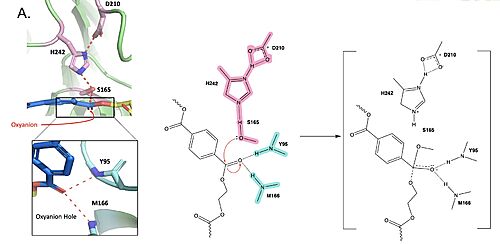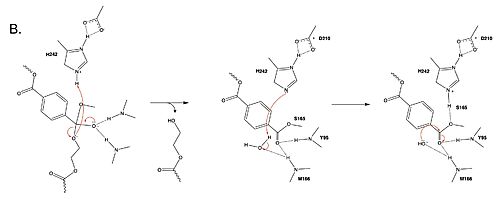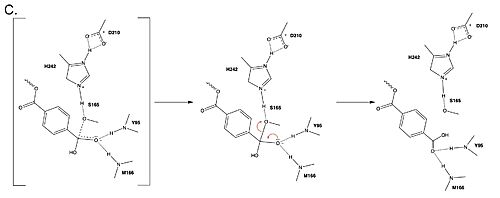User:Anjali Rabindran/Sandbox 1
From Proteopedia
| Line 42: | Line 42: | ||
<center> | <center> | ||
| - | [[Image:PartImechaism.jpg|500 px|center|thumb|Figure 1. The active site of PET hydrolase. The catalytic triad residues are pink, and the oxyanion hole residues are light blue (Y95 and M166). The nucleophilic serine residue (S165) attacks the carbonyl carbon of the PET substrate, forming the first tetrahedral transition state stabilized by the oxyanion hole.]] | + | [[Image:PartImechaism.jpg|500 px|center|thumb|Figure 1. The active site of PET hydrolase. The catalytic triad residues are pink (D210, H242, S165), and the oxyanion hole residues are light blue (Y95 and M166). The nucleophilic serine residue (S165) attacks the carbonyl carbon of the PET substrate, forming the first tetrahedral transition state stabilized by the oxyanion hole.]] |
<br><br> | <br><br> | ||
[[Image:Part2mech.jpg|500 px|center|thumb|Figure 2. Second step of the PET hydrolysis reaction by PETase. The catalytic histidine residue (H242) protonates the leaving group monomer of the PET substrate as the oxyanion collapses and the double bond of S165 is reformed. H242 activates a water molecule, which acts as a nucleophile to attack the acyl-enzyme intermediate at the carbonyl carbon of S165.]] | [[Image:Part2mech.jpg|500 px|center|thumb|Figure 2. Second step of the PET hydrolysis reaction by PETase. The catalytic histidine residue (H242) protonates the leaving group monomer of the PET substrate as the oxyanion collapses and the double bond of S165 is reformed. H242 activates a water molecule, which acts as a nucleophile to attack the acyl-enzyme intermediate at the carbonyl carbon of S165.]] | ||
Revision as of 13:45, 11 April 2025
Contents |
PET Hydrolase!!!!!😁😁😁😊😊😊😊😊
Structure
|
Researchers have been investigating various mutations of PET hydrolase to enhance its catalytic ability. One group of researchers, Tournier et. al., have made mutations in the PET hydrolase active site. They identified the key residues involved in the catalytic mechanism by using a model of the (2-HE(MHET)₃)onto the enzyme (PDB ID 4EB0). The site, mainly a hydrophobic pocket, contained 11 residues targeted for mutagenesis. From this, they identified that the majority of enzymes' specific activity went down; however, the mutation of the to either isoleucine or tryptophan increased specific activity.
The mutation of the F243 position to a tryptophan () was selected for further analysis based on its enhanced catalytic activity in the depolymerization of Pf-PET. The W243 mutation was shown to improve the substrate's binding affinity and increase the enzyme’s activity compared to the wild-type enzyme. This was one of the few variants that exhibited higher activity, and it was further analyzed through differential scanning fluorimetry (DSF) to assess its stability.[1]
Similar to the W243 mutation, the mutation was identified as a variant with improved depolymerization activity of Pf-PET. The I243 mutation in LCC led to better substrate interaction than the wild-type enzyme. After generating all possible variants, this mutation was among the few that exhibited 75% or more of the wild-type specific activity. As with the W243 mutation, DSF was used to determine the melting temperature and thermal stability, supporting the increased activity observed with this mutation.
Results
Table 1. Specific activity and rate of wild-type, WCCG, and ICCG mutants. Initial rate was measured by the calculated rate of reaction by NaOH consumption. Specific activity was measured via pf-PET-depolymerization assay.[1]
| Enzyme | Initial rate (ghydrolyzed PET•L-1•h-1) | Specific activity (mgTAeqh-1•mgenzyme-1) ± SD | |||
|---|---|---|---|---|---|
| Wild-Type | 25.7 | 81.9 ± 5.6 | |||
| WCCG | 30.3 | 75.9 ± 5.9 | |||
| ICCG | 31.0 | 82.0 ± 3.9 |
Mechanism


References
- ↑ 1.0 1.1 Tournier V, Topham CM, Gilles A, David B, Folgoas C, Moya-Leclair E, Kamionka E, Desrousseaux ML, Texier H, Gavalda S, Cot M, Guemard E, Dalibey M, Nomme J, Cioci G, Barbe S, Chateau M, Andre I, Duquesne S, Marty A. An engineered PET depolymerase to break down and recycle plastic bottles. Nature. 2020 Apr;580(7802):216-219. doi: 10.1038/s41586-020-2149-4. Epub 2020 Apr, 8. PMID:32269349 doi:http://dx.doi.org/10.1038/s41586-020-2149-4

